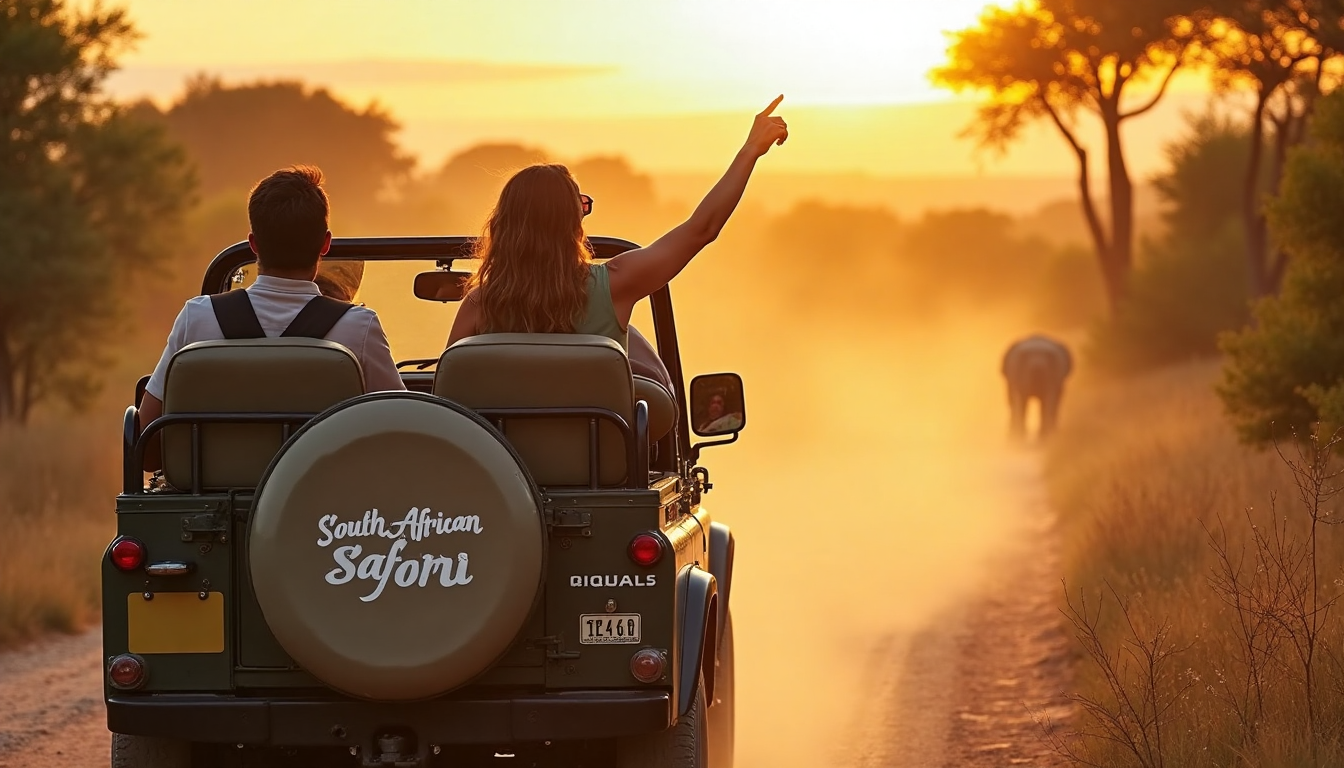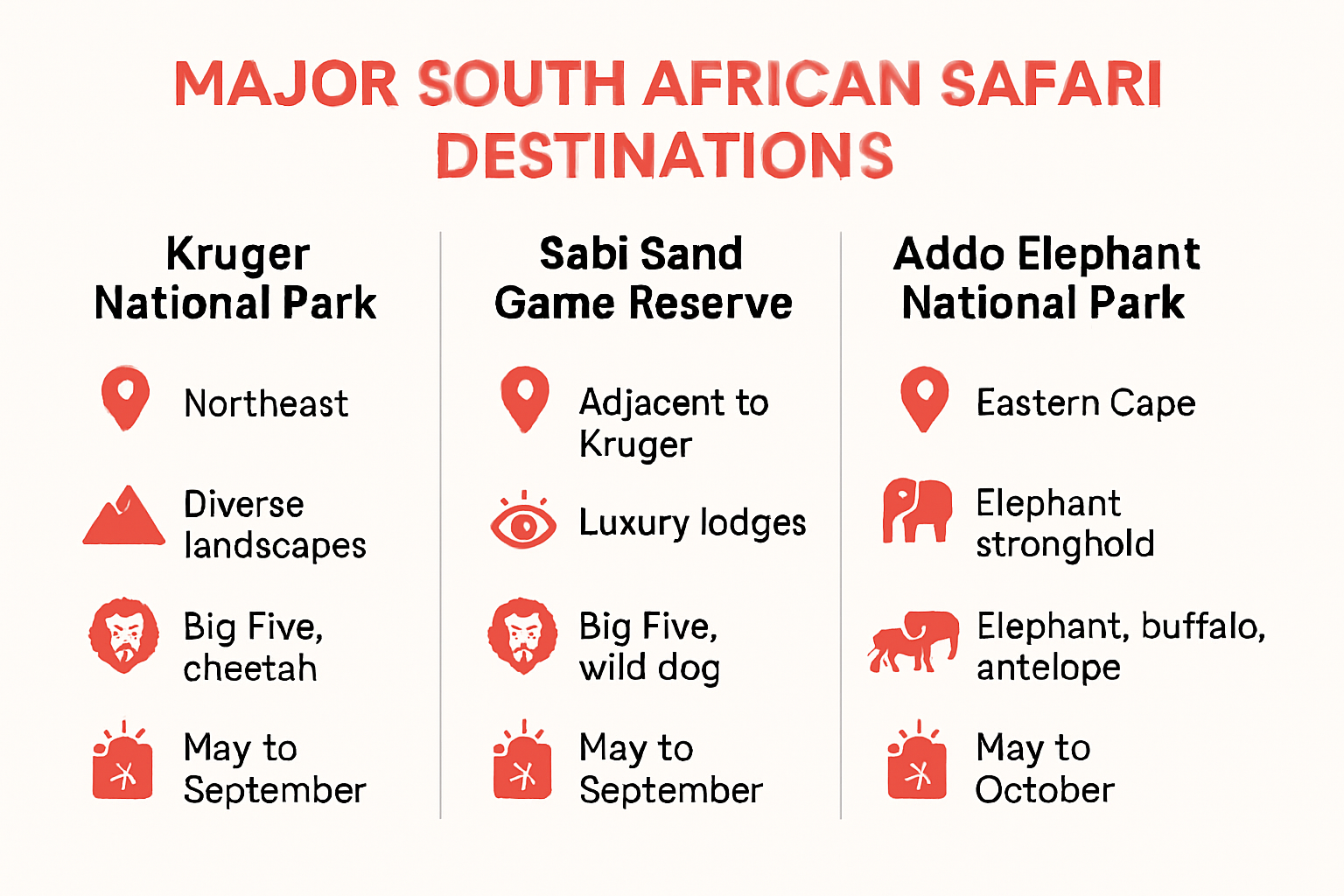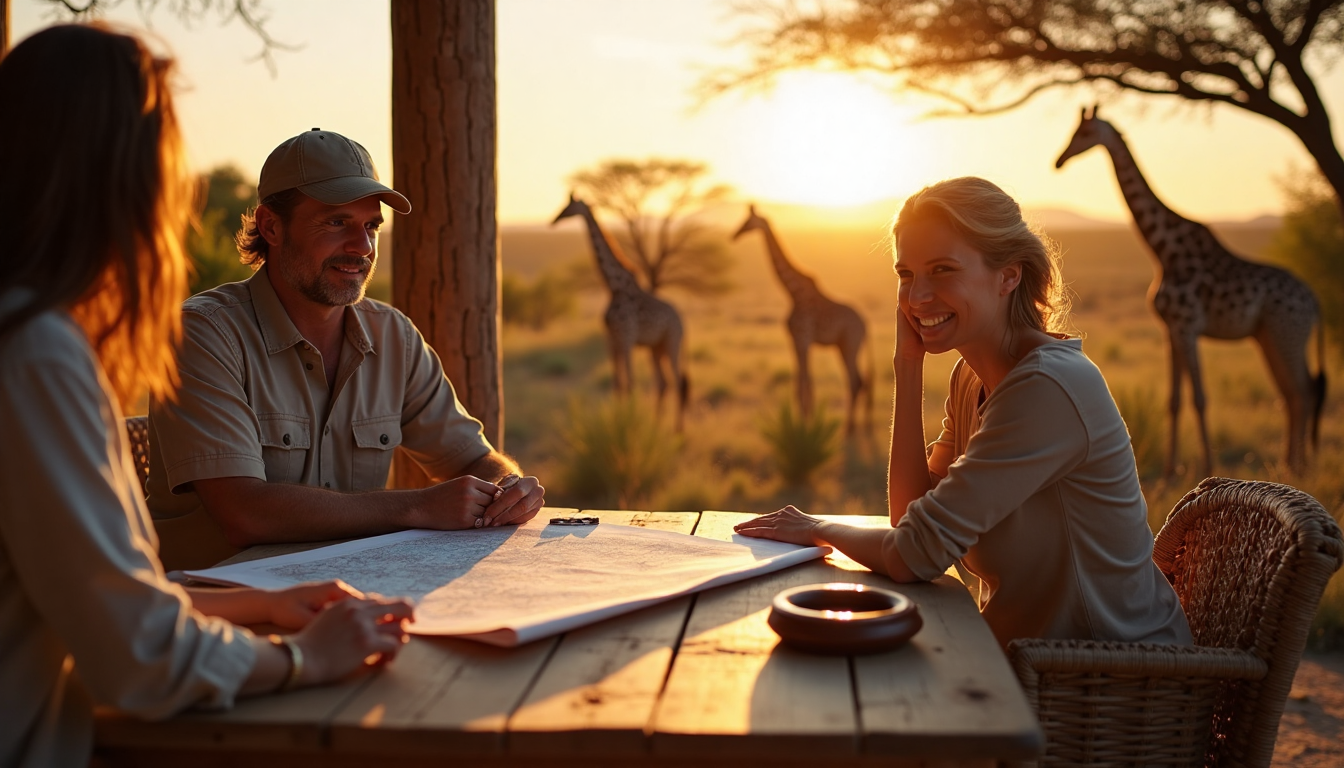Best South African Safari Destinations for 2025 Adventures
Full Disclosure: Our AI Assistant Writes These!
While we're out in the bush tracking leopards, dodging elephants, and trying to get the perfect sunset shot, our trusty AI companion is back at camp, diligently crafting these blog posts. Don't worry though - it's been trained on years of real safari experiences and only occasionally suggests that tourists should pet the lions. (Please don't pet the lions. The AI was joking. We hope.)
The real reason? SEO loves fresh content, and we love fresh adventures. So while our AI handles the keywords and search rankings, we're out there finding the next hidden waterhole, secret viewpoint, or that one tree where the leopards always hang out. Win-win, really!
Best South African Safari Destinations for 2025 Adventures

Imagine stepping into a land where lions, elephants, and rhinos rule and the wild stretches on for as far as the eye can see. Now consider this. Kruger National Park alone protects nearly 20,000 square kilometers and is home to 147 species of large mammals, one of the highest counts on the planet. Yet, the real surprise is that this is just the start. With ancient parks like Hluhluwe–Imfolozi and rare wildlife encounters beyond the Big Five, South African safaris in 2025 promise to deliver experiences that will completely change your view of adventure travel.
Table of Contents
- Top South African Safari Parks And Game Reserves
- Choosing The Right Safari Experience For Your Trip
- Wildlife Highlights And Best Time To Visit
- Travel Tips: Planning Your South African Safari
Quick Summary
| Takeaway | Explanation |
|---|---|
| Explore Diverse Safari Parks | South Africa offers a range of safari parks like Kruger National Park, Hluhluwe–Imfolozi Park, and Pilanesberg National Park, each providing unique wildlife experiences and significant conservation efforts. |
| Match Your Safari to Preferences | Tailor your safari experience based on personal preferences, budget, and family needs, with options ranging from luxury accommodations to budget-friendly packages suitable for families or solo travelers. |
| Plan According to Seasons | Optimal wildlife viewing in Kruger occurs during the dry season (June to October), while the wet season (November to March) presents lush landscapes and newborn animals—plan your visit accordingly for the best experiences. |
| Prioritize Health and Safety | Ensure health precautions, such as vaccinations and malaria prevention, are addressed well in advance; pack essential health supplies and travel insurance for a safe safari experience. |
| Practice Cultural Sensitivity | Engage respectfully with local communities and wildlife; follow strict environmental guidelines and cultural norms to enhance your safari experience and support conservation efforts. |

Top South African Safari Parks and Game Reserves
South African safari destinations offer wildlife enthusiasts an unparalleled journey through some of the most spectacular natural landscapes on the planet. These remarkable parks and game reserves represent more than just wildlife viewing locations—they are living ecosystems that showcase the incredible biodiversity and conservation efforts of the region.
The Crown Jewel: Kruger National Park
At the heart of south-african safari experiences stands Kruger National Park, a world-renowned conservation area that spans nearly 20,000 square kilometers. According to research from the South African National Parks, Kruger hosts an extraordinary 147 species of large mammals, making it one of the most diverse wildlife sanctuaries globally. The park’s exceptional biodiversity includes the iconic Big Five—lions, leopards, elephants, buffalos, and rhinoceroses—which draw adventure travelers from around the world.
Visitors to Kruger can experience multiple ecosystem types, from dense bushveld to open savanna, each supporting unique wildlife populations. The park’s sophisticated conservation strategies have made it a model for wildlife protection, ensuring that these magnificent creatures continue to thrive in their natural habitat. For travelers seeking an immersive wildlife experience, explore our expert-guided safari tours that provide intimate encounters with this extraordinary landscape.

Unique Wildlife Sanctuaries
Beyond Kruger, south-african safari destinations offer remarkable alternatives that provide distinct wildlife experiences. Hluhluwe–Imfolozi Park, established in 1895, holds the distinction of being Africa’s oldest proclaimed nature reserve. This park is particularly renowned for its groundbreaking rhinoceros conservation efforts, having played a critical role in saving the southern white rhinoceros from near extinction.
Pilanesberg National Park presents another extraordinary safari destination, situated within an extinct volcanic crater. Spanning 550 square kilometers, this unique geological formation creates a remarkable ecosystem that supports an incredible diversity of wildlife. The park’s distinctive alkaline ring complex provides a habitat for numerous species, offering visitors a chance to witness wildlife against a truly extraordinary geological backdrop.
Each of these parks represents more than just a tourist destination—they are living museums of biodiversity, conservation success stories, and windows into the complex ecological systems that sustain Africa’s incredible wildlife. Whether you’re a first-time safari traveler or a seasoned wildlife enthusiast, these south-african safari destinations promise unforgettable encounters with nature’s most magnificent creatures.
As conservation becomes increasingly critical, these parks serve not just as wildlife viewing locations, but as crucial sanctuaries protecting some of the planet’s most endangered species. By choosing to visit these remarkable locations, travelers contribute directly to ongoing conservation efforts and support the preservation of these incredible ecosystems for future generations.
Here’s a quick comparison table to help you distinguish the main features and highlights of South Africa’s top safari parks described above.
| Park Name | Size (sq km) | Key Wildlife Features | Unique Attribute | Established |
|---|---|---|---|---|
| Kruger National Park | ~20,000 | Big Five, 147 mammal species, 360+ birds | Diverse habitats, wildlife density | 1898 |
| Hluhluwe–Imfolozi Park | 960 | White & Black Rhino, Big Five | Oldest proclaimed nature reserve in Africa | 1895 |
| Pilanesberg National Park | 550 | Big Five, many antelope, birds | Located in extinct volcanic crater | 1979 |
| Kgalagadi Transfrontier Park | 38,000 (total)* | 500+ bird species, desert-adapted wildlife | Red dunes, cross-border park with Botswana | 2000 (TFP) |
| Marakele National Park | 670 | Cape vulture colony, Big Five | World’s largest Cape vulture colony, biosphere | 1994 |
*Area includes both South African and Botswana sides
Choosing the Right Safari Experience for Your Trip
Selecting the perfect safari experience requires careful consideration of multiple factors that go beyond simply picking a destination. The right safari can transform from a typical vacation into an extraordinary journey of discovery, connecting travelers with the raw beauty of south-african wilderness and its remarkable wildlife.
Understanding Safari Types and Experiences
Safari experiences vary dramatically across south-african landscapes, offering travelers diverse options tailored to different preferences and budgets. Kgalagadi Transfrontier Park exemplifies this diversity, spanning 38,000 km² across South Africa and Botswana, presenting a unique desert safari experience with distinctive red dunes and extraordinary wildlife encounters. The park hosts over 500 bird species and provides a dramatically different environment compared to traditional bushveld safari destinations.
Travelers must consider their personal wildlife viewing preferences. Some might prefer guided walking safaris that offer intimate, ground-level encounters with nature, while others might opt for traditional game drive experiences in open-top vehicles. Marakele National Park, nestled in the Waterberg Biosphere, offers a prime example of diverse wildlife experiences. Here, visitors can witness the world’s largest Cape vulture colony with approximately 800 breeding pairs, alongside traditional Big Five game viewing.
Matching Safari Experiences to Traveler Profiles
Every traveler has unique expectations and comfort levels when embarking on a safari adventure. Budget-conscious travelers can explore affordable safari packages that provide excellent wildlife viewing opportunities without compromising experience quality. Luxury travelers might prefer exclusive private game reserves offering premium accommodations and personalized wildlife tracking experiences.
Families with children require different considerations. Some parks offer more child-friendly experiences with shorter game drives, educational programs, and safer viewing environments. Solo travelers and photography enthusiasts might prioritize parks with diverse landscapes and abundant photographic opportunities.
Consider factors like seasonal variations, wildlife migration patterns, and specific animal behavior when planning your safari. The dry winter months typically offer better wildlife viewing as animals congregate around water sources, making game spotting more predictable. Conversely, the wet summer season transforms landscapes into lush green environments, offering unique photographic and ecological perspectives.
Ultimately, the perfect safari experience is a deeply personal journey. It requires balancing practical considerations like budget, travel duration, and physical comfort with the profound desire to connect with nature’s most extraordinary ecosystems. By understanding your personal preferences and researching destination-specific characteristics, you can craft a safari adventure that becomes a lifetime memory—a true celebration of south-african wilderness and its incredible biodiversity.
Wildlife Highlights and Best Time to Visit
South African safari destinations offer a mesmerizing array of wildlife experiences that shift dramatically with seasonal changes. Understanding these variations can transform a good safari into an extraordinary wildlife encounter, allowing travelers to witness nature’s most spectacular moments.
Seasonal Wildlife Viewing Strategies
Kruger National Park exemplifies the dramatic seasonal wildlife transformations. According to South African National Parks research, the park hosts over 360 bird species and 147 mammal species, with wildlife visibility peaking during the dry season from June to October. During these months, sparse vegetation and concentrated water sources create ideal conditions for wildlife observation.
The dry season presents remarkable opportunities for wildlife photography and tracking. Animals congregate around remaining water sources, making predator and prey interactions more predictable. Herbivores like elephants, buffalos, and various antelope species become more visible as they navigate limited water resources, creating dramatic landscape scenes that capture the essence of survival in the African wilderness.
Unique Wildlife Encounters
Hluhluwe–Imfolozi Park offers another extraordinary wildlife experience, particularly for rhinoceros enthusiasts. As the oldest proclaimed nature reserve in Africa, the park provides exceptional opportunities to witness white and black rhinoceros in their natural habitat. The park’s successful conservation efforts have made it a critical sanctuary for these endangered species.
Marakele National Park presents a unique wildlife spectacle with its remarkable Cape vulture colony, hosting approximately 800 breeding pairs within the Waterberg Biosphere. This park demonstrates the incredible diversity of south-african wildlife beyond the traditional Big Five focus, offering birdwatchers and wildlife photographers extraordinary opportunities to capture rare ecological interactions.
Timing Your Safari Adventure
Timing is crucial when planning a safari experience. While the dry winter months (May to September) offer optimal wildlife viewing, the wet summer season (November to March) presents its own unique attractions. Lush green landscapes, newborn animals, and migratory bird species create a completely different ecological tableau. For travelers seeking a comprehensive wildlife experience, explore our comprehensive African safari packages that capture the nuanced beauty of different seasonal variations.
Beyond seasonal considerations, wildlife viewing depends on multiple factors including animal migration patterns, breeding cycles, and local ecological conditions. Professional guides and carefully planned itineraries can significantly enhance the likelihood of remarkable wildlife encounters. Each south-african safari destination offers a unique window into the continent’s extraordinary biodiversity, promising travelers an immersive journey through some of the world’s most remarkable natural environments.
Ultimately, the magic of a safari lies not just in seeing wildlife, but in understanding the complex ecological systems that sustain these incredible creatures. Whether you’re tracking the Big Five, observing rare bird species, or witnessing the intricate dance of predator and prey, south-african safari destinations offer an unparalleled opportunity to connect with nature’s most profound mysteries.
Here is a table summarising the best times to visit and what wildlife experiences travellers can expect across the major seasons.
| Season | Months | Main Advantages | Key Wildlife Encounters |
|---|---|---|---|
| Dry (Winter) | May – September | Sparse bush, better visibility | Big Five, predators, large herds at waterholes |
| Wet (Summer) | November – March | Lush scenery, baby animals, birds | Newborn wildlife, migratory birds, abundant green landscapes |
| Transition (Spring/Autumn) | April, October | Flexible game viewing, mild weather | Mix of resident and some migratory wildlife |
Travel Tips: Planning Your South African Safari
Planning a south-african safari requires meticulous preparation, combining practical considerations with an understanding of local conditions and wildlife environments. Successful safari experiences demand more than just booking a tour—they require comprehensive planning that ensures safety, comfort, and an immersive wildlife encounter.
Essential Health and Safety Preparations
Travel health is paramount when exploring south-african wilderness. According to the World Health Organization, travelers should consult their healthcare provider at least 4-6 weeks before departure to discuss necessary vaccinations and health precautions. Malaria remains a significant concern in many safari destinations, particularly in Kruger National Park and surrounding regions. Prophylactic medications, insect repellents, and protective clothing are crucial preventive measures.
The South African Department of Tourism recommends comprehensive travel insurance that covers medical evacuation, as some safari locations are remote and medical facilities might be limited. Travelers should pack a comprehensive first-aid kit, including personal medications, rehydration salts, and basic emergency supplies. Consider bringing high-SPF sunscreen, wide-brimmed hats, and lightweight, long-sleeved clothing to protect against intense south-african sun and potential insect exposure.
Practical Travel and Logistics
Navigating south-african safari destinations requires careful logistical planning. According to South African National Parks guidelines, travelers should be prepared for varying road conditions and potential communication challenges in remote areas. Renting a suitable vehicle with high ground clearance and comprehensive insurance is recommended for self-drive safari experiences.
Technology can be both a blessing and a challenge. While many safari lodges offer Wi-Fi, cellular coverage can be unpredictable in wilderness areas. Bring portable chargers, universal adapters, and consider purchasing a local SIM card for emergency communications. Our comprehensive south-african safari packages include communication support and emergency assistance to ensure traveler safety and convenience.
Cultural Sensitivity and Environmental Awareness
Responsible safari travel extends beyond personal preparation—it involves respecting local ecosystems and communities. The South African National Parks emphasize the importance of minimal environmental impact. This means following strict guidelines: staying on designated paths, maintaining appropriate noise levels, avoiding littering, and never disturbing wildlife or removing any natural objects from parks.
Understanding local cultural norms is equally important. Many safari destinations are located near indigenous communities, and respectful interaction requires cultural sensitivity. Learn basic local language greetings, ask permission before photographing people, and be open to learning about local traditions and conservation efforts.
Packing for a safari requires strategic thinking. Opt for neutral-colored clothing that blends with natural environments—avoid bright whites or vibrant colors that might startle wildlife. Lightweight, breathable fabrics that can be layered are ideal, as temperatures can fluctuate dramatically between day and night in south-african wilderness areas.
Finally, approach your safari with an open mind and realistic expectations. Wildlife sightings are never guaranteed, and the true magic of a safari lies in experiencing the raw, unpredictable beauty of nature. Patience, flexibility, and a sense of wonder will transform a simple trip into an extraordinary journey of discovery through south-africa’s remarkable wilderness landscapes.
Frequently Asked Questions
What are the best South African safari destinations for 2025?
South African safari destinations for 2025 include Kruger National Park, Hluhluwe–Imfolozi Park, and Pilanesberg National Park, each offering unique wildlife experiences and diverse ecosystems.
When is the best time to go on a safari in South Africa?
The best time for safari experiences in South Africa is during the dry season, from June to October, when wildlife visibility is higher due to concentrated water sources and sparse vegetation.
What should I consider when choosing a safari experience in South Africa?
When choosing a safari experience, consider factors like your budget, travel preferences, the type of wildlife you wish to see, and whether you prefer guided tours or self-drive options.
Are there health precautions I need to take before going on a South African safari?
Yes, travelers should consult healthcare providers for vaccinations and malaria prevention, as well as pack essential health supplies and travel insurance to ensure safety during their safari adventure.
Ready for a Life-Changing Safari in South Africa?
Planning a South African safari can feel overwhelming when you want to catch the Big Five, choose the perfect park, and travel in the right season. You want an unforgettable wildlife experience, but worry about logistics, safety, and finding a tour that matches your budget and adventurous spirit. Many travelers wonder how to combine authentic encounters, top-reviewed guides, and a custom-made itinerary—without the stress of figuring it out alone.

Africa Awesome is here to turn these worries into new excitement for your 2025 adventure. Find expertly curated safari tours inspired by all the highlights from Kruger National Park, Hluhluwe–Imfolozi, Pilanesberg, and beyond. Connect with travel experts who know exactly when and where you should go for the best wildlife encounters. Discover how easy and secure it is to plan your dream trip with flexible safari packages and real guest reviews.
Your South African journey begins with a single step. Book now on Africa Awesome and experience the wild in a way you will never forget.
Recommended
- South Africa Tours & Safaris | Africa Awesome
- All African Safari Tours & Adventures | Africa Awesome
- All African Safari Tours & Adventures | Africa Awesome
- All African Safari Tours & Adventures | Africa Awesome
- All African Safari Tours & Adventures | Africa Awesome
- All African Safari Tours & Adventures | Africa Awesome